For years, I’ve navigated the world of outdoor adventure on a shoestring budget. Whether it was due to unexpected expenses or spontaneous opportunities, resourcefulness has always been key. Now, Walmart, a retail giant, is stepping into the cycling arena, aiming to redefine affordability in the gravel bike market.
Following the buzz generated by their budget-friendly Ozark Trail mountain bikes, Walmart has introduced its first-ever gravel bike: the Ozark Trail G.1 Explorer. This drop-bar, 29-inch wheel bike, boasting features like generous mounting points, is priced under $250. Set to become a fixture in Walmart’s ubiquitous bike aisles, it has the potential to significantly impact the entry-level adventure cycling scene.
Intrigued by this development, I decided to put the Ozark Trail G.1 Explorer to the test. Days before its wider release, I managed to obtain one from Walmart’s headquarters in Bentonville, Arkansas.
My mission was clear: traverse the Ozark region, exploring hundreds of miles of newly established bikepacking routes around Fayetteville. This journey, culminating in Little Rock, would serve as a real-world trial for the new Ozark Trail bike on trails bearing the same name – promising some surprises along the way.
In essence: After riding this bike nearly 300 miles, from Walmart’s backyard to the Arkansas state capital, I encountered both commendable aspects and notable drawbacks. The brakes were concerning, and the drivetrain presented challenges. However, the abundance of mounting points was a standout feature, surpassing even some higher-end bikes I’ve ridden. Above all, the astonishing price point left me pondering if the Ozark Trail G.1 could indeed disrupt the cycling industry.
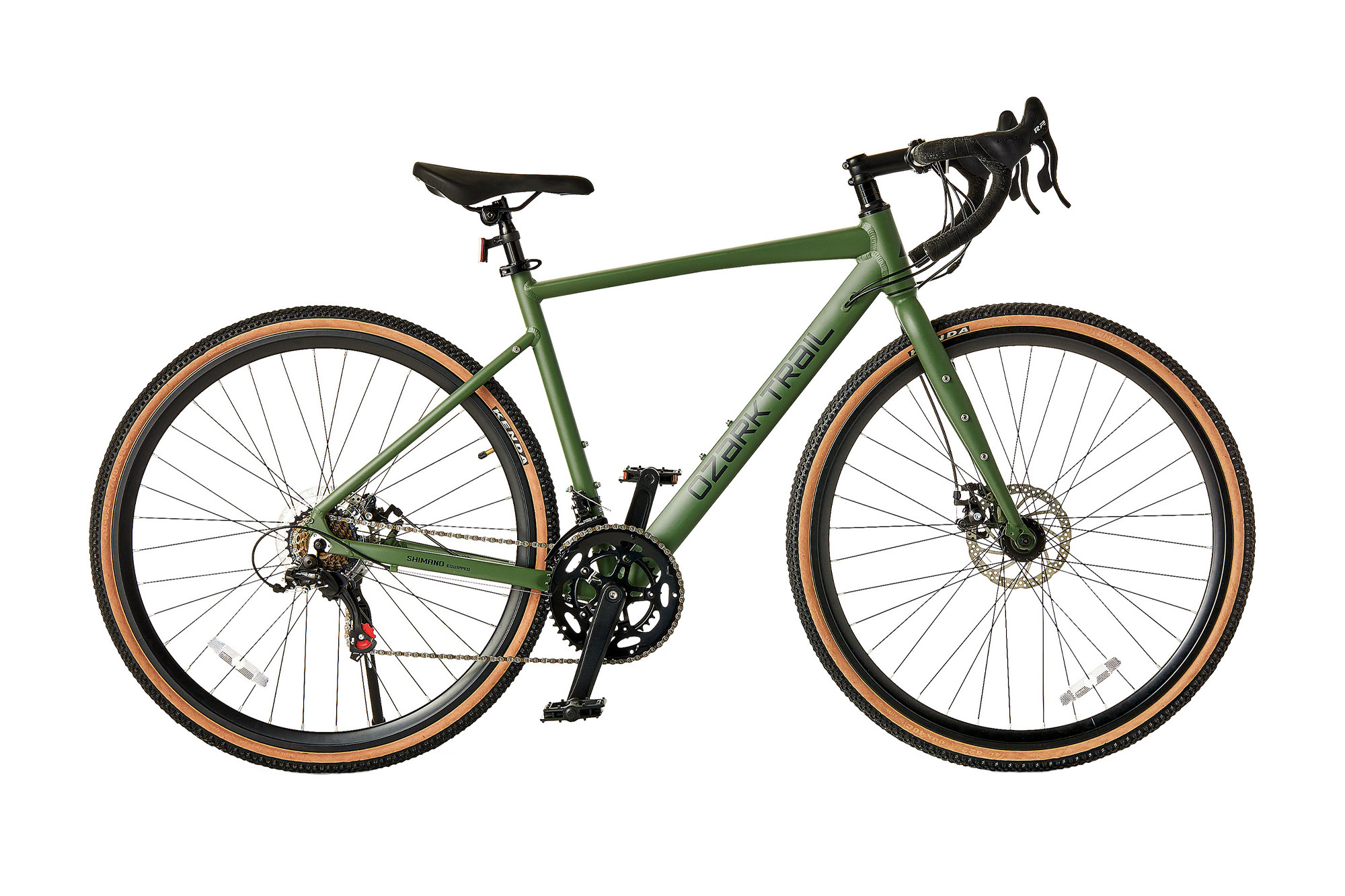 Ozark Trail G.1 Explorer gravel bike review on Ozark trails
Ozark Trail G.1 Explorer gravel bike review on Ozark trails
Ozark Trail G.1 Explorer in action, traversing gravel paths. The image showcases the bike’s profile and its suitability for diverse terrains.
Ozark Trail G.1 Explorer: Key Specifications
- Weight: 30.4 lbs.
- Fork: Steel, quick release with mounts
- Frame: 6061 aluminum
- Sizes: Small and medium, 29” tires
- Drivetrain: L-TWOO 2×7, with Shimano Tourney rear derailleur
- Handlebar: Drop bar; 400mm top width with 15-degree flare
- Stock tires: Kenda 700x40c, soft gum sidewalls
- Stack: 560 mm (medium)
- Reach: 395 mm (medium)
- Wheelbase: 1,034 mm (medium)
- Fork geometry: 72-degree head tube; 63mm trail
Pros
- Unbeatable budget-friendly price
- Versatile front fork mounts
- Well-rounded gravel riding geometry
- Comfortable handlebar flare
Cons
- Questionable brake performance
- Stiff and less responsive shifting
- Heavy frame impacting agility
- Puncture-prone stock tires
Initial Thoughts on the Ozark Trail G.1
My first encounter with the Ozark Trail G.1 Explorer, upon taking it out of the van, centered on its sizing. The medium frame I was about to test for two weeks presented a stack height of approximately 56 cm and a reach of around 40 cm.
Ozark Trail G.1 Explorer Gravel Bike assembly time lapse; (video/Ian Graber-Stiehl)
Being just under 6 feet tall, and typically riding a large frame due to my longer limbs, I was initially skeptical. However, my shorter torso surprisingly made the medium-sized Ozark Trail Gravel Bike (this medium-sized bike) manageable for the planned long-distance ride. It’s worth noting that Walmart offers the Explorer only in small and medium sizes, which may limit its appeal for taller riders.
What immediately stood out were the bike’s numerous mounting points. I’ve experienced far pricier bikes marketed for gravel, touring, or adventure riding with fewer options for gear attachment. The Ozark Trail G.1 features three mounting points within the main triangle for water bottles and front fork mounts ideal for racks or cages. This thoughtful design allowed me to easily install my trusty Old Man Mountain Pizza and Divide racks.
 Ozark Trail G.1 Explorer front fork with mounting points
Ozark Trail G.1 Explorer front fork with mounting points
Close-up of the Ozark Trail G.1 Explorer’s front fork, highlighting the practical mounting points. This feature enhances the bike’s versatility for adventure riding and bikepacking.
This design choice also aligns perfectly with Walmart’s budget-conscious ethos. Riders looking to minimize expenses can maximize the utility of racks by using dry bags, affordable panniers, or even repurposed trunk bags, rather than investing in more expensive, trendy bikepacking bags.
While my rack choices might not have been the absolute cheapest available, I opted for a functional approach, pairing them with my oldest and most well-worn trunk bags and panniers, emphasizing practicality over aesthetics.
The geometry of the Explorer also seemed to prioritize function. With a 72-degree head tube angle, approximately 44mm of fork offset, 440mm chainstays, and a wheelbase around 1,035mm, the Ozark Trail G.1 Explorer embodies classic gravel bike geometry principles. The handlebar drops appeared somewhat deep, but the 15-degree flare offered a reasonable compromise, suggesting a design aimed at versatility and rider comfort.
First Ride Impressions
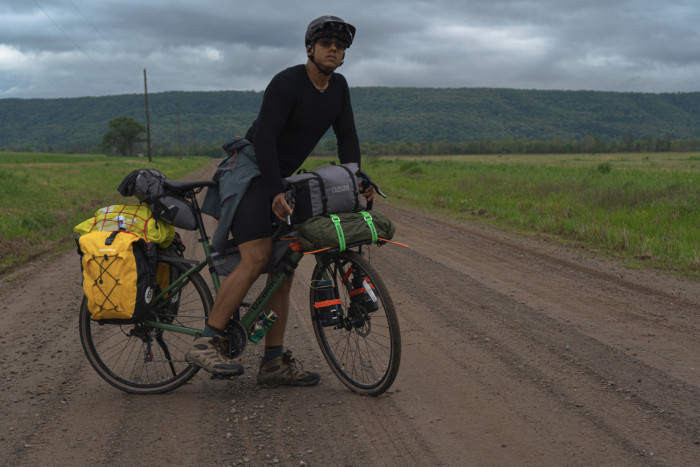 Ozark Trail G.1 Explorer gravel bike rider on initial test ride
Ozark Trail G.1 Explorer gravel bike rider on initial test ride
A cyclist test-riding the Ozark Trail G.1 Explorer on a gravel path. The image captures the bike in motion, demonstrating its performance in a natural setting.
“I’ve heard about it, but haven’t seen one in person yet,” remarked the mechanic at Phat Tire, a local bike shop. “For better or worse, this bike is going to change the game for a lot of people.” With his words echoing in my mind, and spare inner tubes packed, I embarked on the Ozark Trail G.1 Explorer gravel bike’s inaugural ride.
Fayetteville is undeniably a cycling-centric city. The 40-mile Razorback Greenway paved trail runs through its heart, branching off into numerous other trails, ranging from gentle paths to more technical routes with sharp turns under bridges, many bustling with pedestrians. I had three days to explore these trails before venturing into the Ozark backcountry.
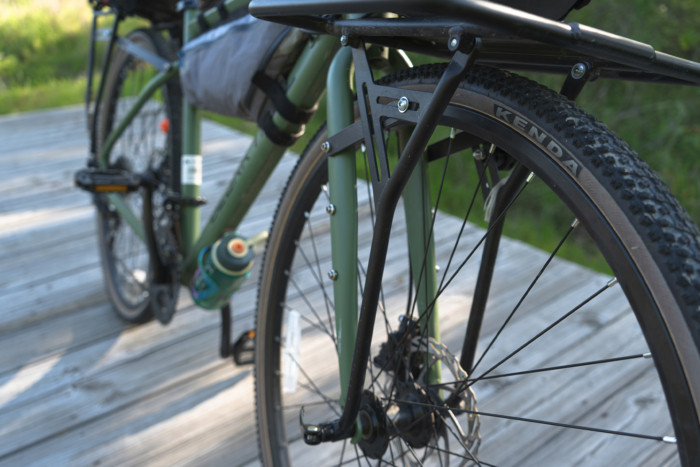 Ozark Trail G.1 Explorer front tire and fork detail
Ozark Trail G.1 Explorer front tire and fork detail
Close-up of the Ozark Trail G.1 Explorer’s front tire and fork. The image emphasizes the tire tread and the bike’s front assembly.
The stock tires, seemingly inspired by Kenda’s Booster Pros, performed adequately for paved commuting. However, factoring in my weight, camera gear, racks, bags, and fishing equipment, I was adding up to around 265 pounds on the bike. The tires’ soft sidewalls would require higher pressure to prevent bottoming out on more challenging terrain.
The shifting, while stiff, was surprisingly consistent. Maintaining speeds up to 26 mph on flat surfaces and gentle downhills was achievable. Uphill climbs, however, presented a different scenario.
The 2×7 L-TWOO drivetrain offered a limited gear range. For the intended entry-level market, prioritizing smooth shifting over a wider range with budget components is a reasonable compromise. Yet, as I pushed this bike up the first steep paved incline, overtaken by cyclists training for the U.S. Mountain Bike Pro Cup, I anticipated more uphill struggles in the Ozark mountains.
One aspect caused immediate concern: the brakes. While I expected some initial adjustments might be necessary, achieving reliable stopping power without constant rotor rub proved difficult. Hauling 265 pounds, I foresaw potentially precarious descents ahead.
Uphill Battles and Unexpected Setbacks
 Ozark Trail G.1 Explorer handlebars with L-TWOO shifters
Ozark Trail G.1 Explorer handlebars with L-TWOO shifters
Handlebar view of the Ozark Trail G.1 Explorer, showcasing the flared drop bars and L-TWOO shifters. This highlights the cockpit setup of the bike.
The initial two days of trail riding were ambitious, to say the least. I was tasked with testing 50 miles of an uncompleted bikepacking route ascending a mountain – a demanding challenge for any bike, especially a budget model, and even more so when compounded by a sudden onset of strep throat.
The Explorer’s frame handled the demanding conditions surprisingly well. Its slight flex felt appropriate given the heavy load. The front fork struck a balance, offering enough slack for stability without feeling unresponsive when loaded with gear and water.
The cockpit ergonomics were a mixed bag. The hoods were reasonably comfortable for extended periods. However, the drops felt somewhat deep for anything beyond smooth descents. On rougher terrain, wider handlebars would have been preferable, though not a primary concern.
Within those first two days, the limitations of the brakes, drivetrain, and tires became apparent on steep inclines and descents characterized by a mix of gravel and loose rocks ranging from golf ball to baseball size. This terrain pushed the components beyond their intended capabilities.
The Explorer is adequately equipped for bikepacking in gentler hill country and unloaded rides on moderately steep terrain. However, the approach to the Ozarks’ White Rock Mountain was anything but moderate. Feeling increasingly unwell, I found myself pushing the Explorer up hills I would typically ride on most gravel bikes.
Two flat tires in as many days further hindered progress. The Kenda tires might have been enjoyable on smoother, more compact gravel. Yet, with nearly 300 pounds of total weight on routes riddled with sharp rocks, downhill sections invariably resulted in bottoming out and pinch flats.
By the second day, braking on descents became genuinely alarming. Between fixing flats, worsening illness, and falling behind schedule for an eclipse viewing, time for brake adjustments was scarce. This led to some unnerving descents at speeds around 15 mph, relying more on luck than braking confidence.
Finding the Ozark Trail G.1 Explorer’s Ideal Terrain
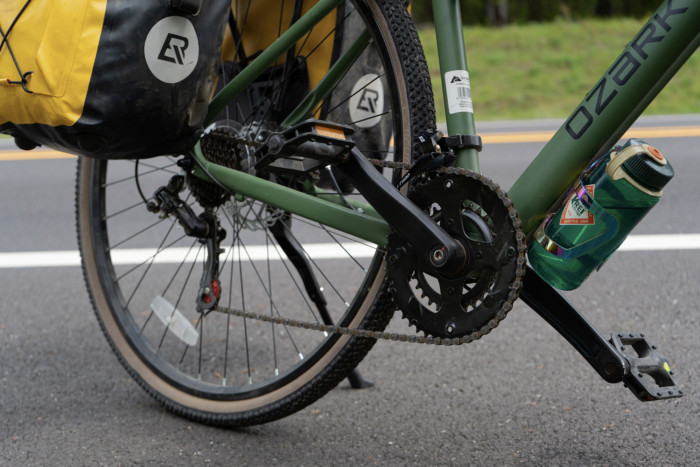 Ozark Trail G.1 Explorer drivetrain components
Ozark Trail G.1 Explorer drivetrain components
Detailed view of the Ozark Trail G.1 Explorer’s drivetrain. The image focuses on the L-TWOO components and Shimano Tourney rear derailleur, key elements of the bike’s performance.
Plan B became essential, revealing the Explorer’s strengths. Weakening and running out of tire patches, I opted for a strategic detour. The remaining 200 miles would follow a combination of paved roads and harder-packed gravel paths closer to main highways. Flats ceased to be an issue, as the larger, sharp rocks were no longer a factor.
The drivetrain now felt more appropriate for the milder dirt, gravel, and paved surfaces. The constant pushing was over. Instead, the limited gear range, initially a drawback, now minimized the impact of the stiff shifting by creating smaller steps between gears.
After approximately 125 miles of demanding riding, the brakes and front derailleur required some attention with an Allen wrench to readjust. Post-adjustment, neither component operated flawlessly (and the brakes remained noisy), but they became dependably functional.
I concluded the extended test ride with three days of regular city commuting. The Explorer proved to be a surprisingly agile and practical urban ride.
Ozark Trail G.1 Explorer: Value and Verdict
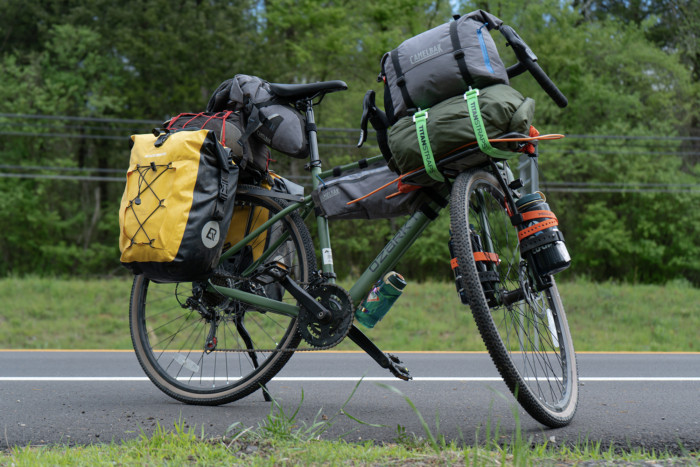 Ozark Trail G.1 Explorer gravel bike on scenic road
Ozark Trail G.1 Explorer gravel bike on scenic road
The Ozark Trail G.1 Explorer on a paved road, highlighting its versatility for different riding environments. The setting suggests a scenic, accessible route suitable for the bike.
The defining feature of the Ozark Trail G.1 Explorer is its MSRP of $248. This price point is lower than some high-end handlebars or saddles (Specialized Aethos Pro handlebars or saddles).
I’ve detailed the challenges I encountered with the Ozark Trail G.1 Explorer. The bike’s shifting, braking, tires, and other aspects were, at times, frustrating and, in the worst instances, unsettling.
Yet, it successfully transported a 265-pound rider and gear through the Ozark Mountains for under $250. That is a remarkable feat.
Many of the identified shortcomings diminish with lighter loads and less extreme terrain. And, undeniably, certain performance characteristics are merely adequate when compared to gravel bikes costing ten times as much. Furthermore, the Ozark Trail G.1 Explorer’s limited size range is a constraint.
Nevertheless, for lighter adventurers, the Explorer is a capable machine. It stands to become one of the most accessible gravel bikes on the market. Despite any refinement it may lack, the combination of widespread availability, inherent capability, and an exceptionally low price—where components can cost more—positions the Ozark Trail Explorer G.1 as a serious contender for budget-conscious adventurers, poised to, as the bike mechanic predicted, “shake things up.”
[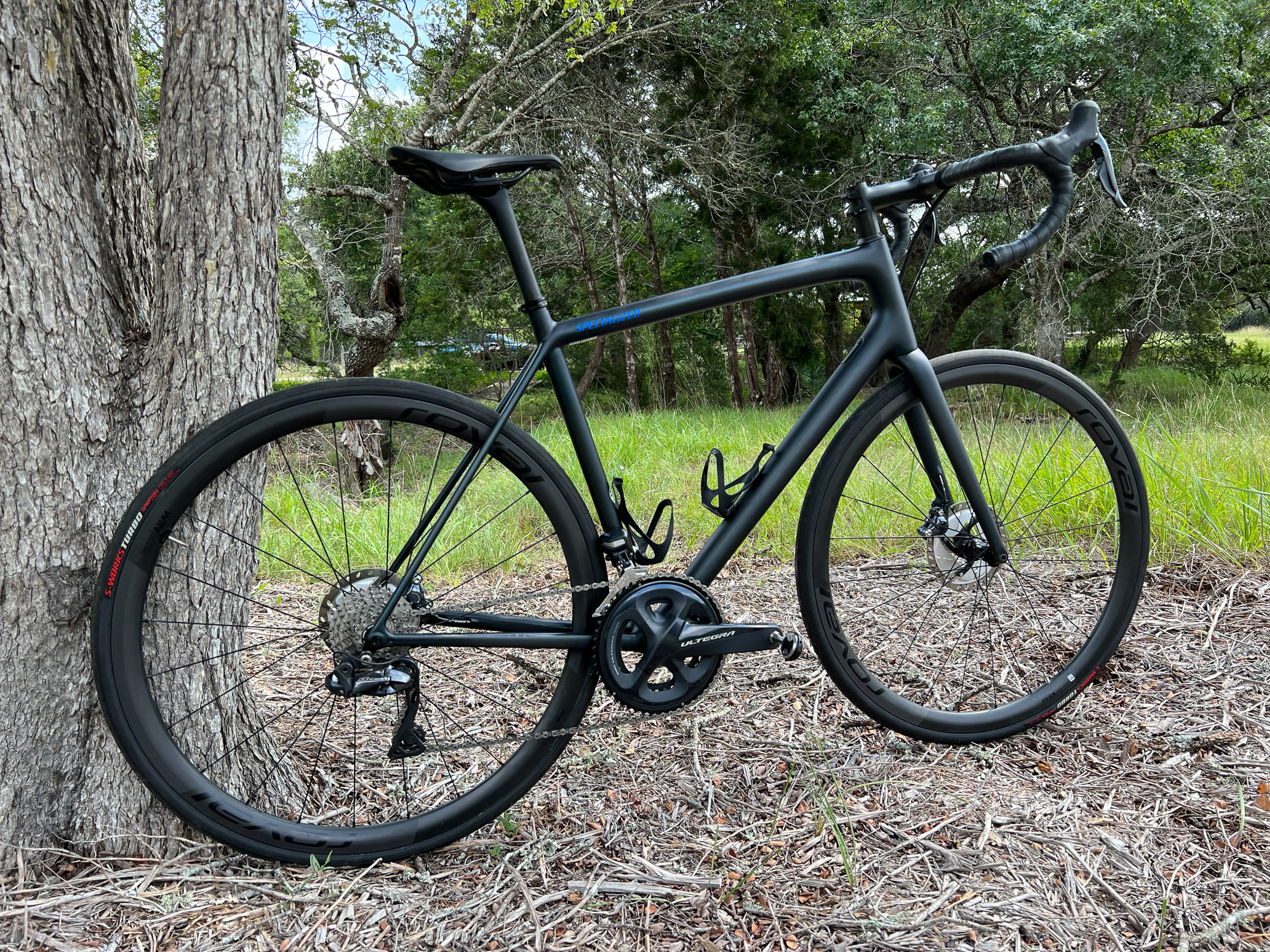 Specialized Aethos Pro
Specialized Aethos Pro
Mythical and Mesmerizing Road Feel: Specialized Aethos Pro Road Bike Review
If ride quality is your top priority, the Specialized Aethos Pro will impress. Its exceptional road feel is unparalleled among road bikes. Read more…

